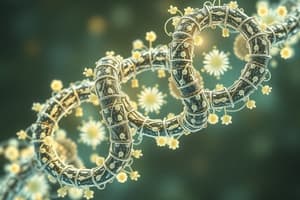Podcast
Questions and Answers
What is the primary energy currency of cells?
What is the primary energy currency of cells?
- Lipids
- RNA
- ATP (correct)
- DNA
What are the components of ATP?
What are the components of ATP?
- Adenine base, Ribose sugar, and Two phosphate groups
- Thymine base, Deoxyribose sugar, and Two phosphate groups
- Adenine base, Ribose sugar, and Three phosphate groups (correct)
- Guanine base, Ribose sugar, and Three phosphate groups
Which enzyme does ATP inhibit in glycolysis?
Which enzyme does ATP inhibit in glycolysis?
- Fumarase
- Phosphofructokinase-1 (PFK1) (correct)
- Hexokinase
- Pyruvate dehydrogenase
What is the intracellular concentration range of ATP?
What is the intracellular concentration range of ATP?
What process does ATP provide energy for in muscle cells?
What process does ATP provide energy for in muscle cells?
How does ATP function in cellular signaling?
How does ATP function in cellular signaling?
What is the primary location for ATP synthesis in the cell?
What is the primary location for ATP synthesis in the cell?
Which process is NOT mentioned as a way ATP is consumed in the body?
Which process is NOT mentioned as a way ATP is consumed in the body?
How many moles of ATP does a human body's cells require per day for proper functioning?
How many moles of ATP does a human body's cells require per day for proper functioning?
Which of the following is NOT mentioned as a function of ATP in cellular processes?
Which of the following is NOT mentioned as a function of ATP in cellular processes?
What role does ATP play in intracellular signaling?
What role does ATP play in intracellular signaling?
Which statement best describes the regulatory relationship between ATP and PFK1 in glycolysis?
Which statement best describes the regulatory relationship between ATP and PFK1 in glycolysis?
Flashcards are hidden until you start studying
Study Notes
Adenosine Triphosphate (ATP)
Adenosine triphosphate (ATP) is the primary energy currency of cells, providing energy for various cellular functions. ATP is a nucleoside triphosphate consisting of an adenine base, a ribose sugar, and three phosphate groups. These phosphate groups are linked through high-energy phosphoanhydride bonds, which release energy when broken. The structure of ATP allows it to store and transfer energy efficiently, making it a crucial molecule for the proper functioning of cells.
Cellular Level
ATP plays a vital role at the cellular level as an energy storage molecule and currency. It is continuously replenished to fuel cellular processes. The intracellular concentration of ATP is maintained in the range of 1 to 10 μM. Feedback mechanisms regulate ATP synthesis, ensuring that it is available when needed. For example, ATP inhibits phosphofructokinase-1 (PFK1) and pyruvate kinase, key enzymes in glycolysis, and promotes ATP synthesis in times of high-energy demand.
Function
ATP hydrolysis provides energy for many essential cellular processes, such as intracellular signaling, DNA and RNA synthesis, muscle contraction, and active transport. It is involved in cellular signaling, serving as a substrate for kinases, which can activate cascades leading to the modulation of diverse intracellular signaling pathways. ATP also functions as a ubiquitous trigger of intracellular messenger release, including hormones, enzymes, and lipid mediators.
ATP Synthesis and Consumption
ATP is primarily synthesized through cellular respiration in the mitochondrial matrix, where it generates approximately thirty-two ATP molecules per molecule of glucose that is oxidized. It is consumed in processes such as ion transport, muscle contraction, nerve impulse propagation, substrate phosphorylation, and chemical synthesis. In a human body, cells require 100 to 150 moles of ATP per day to ensure proper functioning.
Significance in Cellular Functions
ATP is essential for intracellular signaling, DNA and RNA synthesis, purinergic signaling, synaptic signaling, active transport, and muscle contraction. In intracellular signaling, ATP serves as a substrate for kinases, which can activate signaling cascades leading to the modulation of diverse intracellular signaling pathways. Additionally, ATP can function as a ubiquitous trigger of intracellular messenger release, including hormones, various enzymes, and lipid mediators.
Regulation of ATP Synthesis
Several regulatory mechanisms control ATP synthesis. For example, ATP inhibits phosphofructokinase-1 (PFK1) and pyruvate kinase, key enzymes in glycolysis, effectively acting as a negative feedback loop to inhibit glucose breakdown when there is sufficient cellular ATP. Conversely, ADP and AMP can activate PFK1 and pyruvate kinase, promoting ATP synthesis in times of high-energy demand. In the heart, mitochondrial flashes can disrupt ATP production, with mitochondria releasing reactive oxygen species and effectively pausing ATP synthesis. During low demand for energy, mitochondrial flashes were observed more frequently, while during high energy output, they occurred less often, allowing for continued ATP production.
Studying That Suits You
Use AI to generate personalized quizzes and flashcards to suit your learning preferences.




